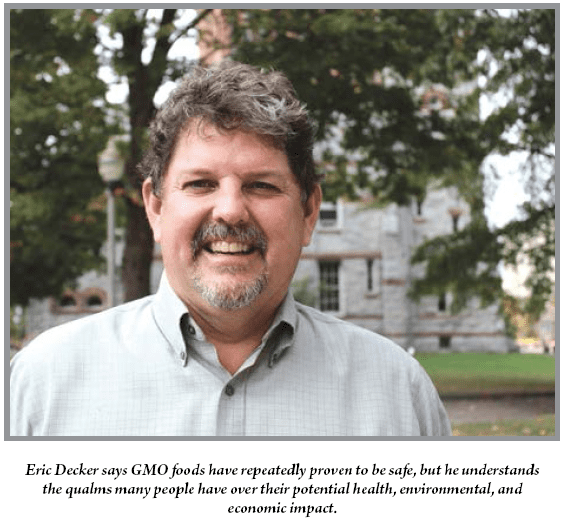Cracking the Code – Genetically Modified Foods Are Ubiquitous — but Are They Safe?
There’s a question Dr. Richard Wood likes to pose to students.
“I will say, ‘how many of you know somebody with a food allergy?’ I’ve done this for years, and every time, every single hand goes up,” said Wood, assistant professor of Exercise Science at Springfield College. “Then I say, ‘when you go home tonight, call or text your parents and ask them the same question about when they were in school. What do you think the answer will be?”
It’s a question worth pondering; doctors have indeed grappled with a surge of food allergies in the past 20 to 30 years. Some cite the ‘hygiene hypothesis,’ the idea that kids today stay too clean, too sanitized, and aren’t exposed to enough germs to keep their immune system busy, causing that system to turn on itself in the form of allergies.
But others are taking a critical look at what we eat today, from heavily processed, chemical-laden junk food to the proliferation of foods containing genetically modified organisms, or GMOs. Introduced to the commercial market about two decades ago, GMO foods are estimated to be present in some 80{06cf2b9696b159f874511d23dbc893eb1ac83014175ed30550cfff22781411e5} of the items in the average grocery store.
“These have been around for 20 years, and no overt medical problems have been caused by them. But some people are concerned there are more subtle issues going on,” Wood said — like that startling rise in food allergies. But no one, it seems, knows for sure.
“It’s incredibly difficult to trace [an allergy] back to the GMO because we haven’t tracked it,” he went on. “People don’t necessarily know how much GMO product they’ve eaten and when they’ve eaten it, so if someone develops a food allergy, it’s really tough to say it’s caused by that.”
Genetically modified foods are produced from organisms that have had changes introduced into their DNA through genetic engineering — techniques that have allowed for the introduction of new crop traits as well as greater control over a food’s genetic structure.
The commercial sale of GMO food began in 1994, when Calgene introduced its Flavr Savr delayed-ripening tomato, which was genetically modified to slow the ripening process after picking. Since then, genetic modification has focused primarily on cash crops in high demand by farmers. As of last year, roughly 85{06cf2b9696b159f874511d23dbc893eb1ac83014175ed30550cfff22781411e5} of corn, 91{06cf2b9696b159f874511d23dbc893eb1ac83014175ed30550cfff22781411e5} of soybeans, and 88{06cf2b9696b159f874511d23dbc893eb1ac83014175ed30550cfff22781411e5} of cotton produced in the U.S. are genetically modified.
Considering how many products contain corn and soybeans alone, it’s not difficult to comprehend the reach of GMO food.
“The only way to get food that does not have GMOs is to buy certified organic food,” said Eric Decker, who chairs the Department of Food Science at UMass Amherst. “Almost all soybean and corn is GMO, and a lot of byproducts come from those; it’s really hard to find non-GMO food. Also, all livestock is fed GMO, too.”
Another early GMO food is known as the Roundup Ready Soybean, which was designed to be resistant to herbicides (like the commonly used Roundup brand). “Roundup kills everything, so they genetically altered the soybean so it would not be susceptible to Roundup,” Decker said. “Farmers could use Roundup to kill everything on the field, then plant soybeans with no danger.”
The general scientific consensus is that food derived from GMO crops poses no greater risk to human health than conventional food. Still, a cottage industry of anti-GMO activism has sprung up, with objections ranging from safety issues to environmental qualms to economic concerns — specifically the fact that genetically modified seeds are subject to intellectual property rights owned by multi-national corporations, most notably Monsanto.
Margaret Smith, a plant breeder at Cornell University, acknowledged in an interview with grist.org that many concerns exist, but she remains confident in the potential benefits of GMO technology.
“I think we need to be thoughtful, and as we learn more, we need to continue to think about this carefully,” she said. “My message on this is that we shouldn’t just stop because there are unknowns. Every technology has unknowns. We just have to be as thoughtful as we can.”
Gut Check
Wood recently became director of Springfield College’s Center for Wellness Education and Research, and he’s long had a keen interest in the broad topic of what people eat and where their food comes from.
When discussing the potential effect of genetically modified food, he begins by discussing what’s known as the human microbiome.
“We have trillions of bacteria that live in our intestinal tract, and they all have their own genome — what makes up their genetic code — and we as people have the same thing,” he explained. “You take all these types of genomes interacting with each other, and there’s an ideal level at which they interact. What we’re starting to see, possibly, is that some of these GMO products are causing different interactions than what existed before. That’s where it’s getting interesting.”
Decker stressed that genetically modified organisms have never proven to be unsafe, although the potential is always there. “The DNA is different, but we don’t absorb the DNA; it’s all broken down in our gut. We don’t absorb it. So the risk to a human is pretty minimal.”
He puts more stock on risk to the environment, because as the modified genes spread, the agricultural world could end up with less diversity. Also, “there’s a lot of criticism in the farming model; even if the farmer next door doesn’t want to grow GMO, eventually he’ll see GMO genes in his crop as well.” Wood added that many anti-GMO advocates are concerned about the long-term impact of GMO agriculture on soil quality, cross-contamination, wildlife, and water sources.
The economic model has come in for criticism as well. Decker said Monsanto makes farmers sign a contract committing to buying new seed every year, where, in the past, farmers would hold over some of their crop every year to reseed from it. “That’s how Monsanto makes money — it sells them something every year. Even with all that, it’s still economically favorable for farmers to buy these seeds.”
Proponents say GMO crops offer the potential for greater yields, which could be a significant benefit for a planet whose population is constantly rising.
“The debate over genetically modified crops and food has been contaminated by political and aesthetic prejudices: hostility to U.S. corporations, fear of big science, and romanticism about local, organic production,” argues Paul Collier, professor of Economics at Oxford University, in the New York Times. “Refusing genetic modification makes a difficult problem more daunting. Food supply is too important to be the plaything of these prejudices. If there is not enough food, we know who will go hungry.”
As director of the Center for the Study of African Economies, he knows something about this issue.
“As Africa’s climate deteriorates, it will need to accelerate crop adaptation,” Collier notes. “As population grows, it will need to raise yields. Genetic modification offers both faster crop adaptation and a biological, rather than chemical, approach to yield increases.Opponents talk darkly of risks, but provide no scientific basis for their amorphous expressions of concern. Meanwhile, the true risks are mounting.”
In the same article, however, Vandana Shiva — founder of Navdanya, a movement of 500,000 seed keepers and organic farmers in India — rejects the idea that GMO crops are the best solution to overpopulation and drought.
“We need biodiversity intensification that works with nature’s nutrient and water cycles, not against them. Genetic engineering has not increased yields,” she notes, citing research by the Union of Concerned Scientists. “The study did not find significantly increased yields from crops engineered for herbicide tolerance or crops engineered to be insect-resistant.
“The International Assessment of Agricultural Science and Technology for Development carried out by 400 scientists over four years has also concluded that genetic engineering does not hold much promise,” she adds. “Instead, small farms based on principles of agri-ecology and sustainability produce more food.”
Meanwhile, the Non-GMO Project, which argues against genetically modified foods, emphasizes that most developed nations do not consider GMOs to be safe, and that, in more than 60 countries around the world — including Australia, Japan, and the entire European Union — there are significant restrictions or outright bans on the production and sale of GMOs.
“There’s a lot of hysteria out there, but in Europe it’s even worse,” Decker told HCN, noting that GMO seed producers such as Monsanto and DuPont have been rebuffed by the European Union so often that they’ve stopped submitting products for approval there.

“But I think GMOs are here to stay,” he added. “Next-generation GMOs may offer greater yields and drought resistance, so you can plant in areas where you can’t plant crops now. And there are some good statistics saying pesticides are being taken out of the environment with GMOs.”
Pros and Cons
Wood acknowledged that many of the scientists behind GMO technology are acting with the world’s good in mind.
“We’ve been eating GMO products for 20 years, and I don’t think anyone ever intended negative consequences,” he said. “I think what we have are innovative folks trying to solve some real problems, and along with the solutions come some consequences. But the issue is, we don’t really know about some of those consequences yet. As I say in class, we’re kind of all human guinea pigs in this experiment.”
For example, “if climate change is a real thing, and let’s say more droughts are in front of us, what if a scientist can create a seed for crops that can resist drought? If climate change is a real problem that needs facing, that scientist has done a lot to help us. On the other hand, when you manipulate what that seed would normally do, you are manipulating the chemical composition of what’s going into the body, and that has a direct interaction with the human microbiome.”
One major issue for people concerned about GMO foods is clearer labeling of products in supermarkets. They are encouraged on that front by recent legislative developments, such as the decision of U.S. lawmakers last September not to renew a provision of agricultural law known colloquially as the ‘Monsanto protection act,’ which protected seed producers from liability if their products are found to be harmful.
“Labeling of this has become the new big issue,” Wood said, before asking rhetorically why Monsanto and others are spending so much money to prevent people from knowing what’s in their food. “They’d probably say they’re protecting their intellectual property, but I don’t know.”
Nathaniel Johnson, the grist.org writer who interviewed the Cornell plant breeder, takes a balanced approach to the GMO controversy.
“Those of us who are suspicious of genetically engineered foods need to be thoughtful, too,” he writes. “I still think that we have an important role to play in making sure the technology isn’t used inappropriately. But it’s not useful to flail blindly against something we don’t understand.”
Wood takes the same thoughtful approach. “It’s more about us being aware of what’s going on,” he told HCN. “The way I look at it, these aren’t intended consequences. And if they exist, scientists aren’t looking to cause problems; they’re trying to solve them.”
But those good intentions do nothing to minimize the concerns he has with what Americans are — unknowingly, in many cases — sending into their collective gut.
“If you eat like crap now, it’s not like eating like crap 20 or 30 years ago,” he said. “People say, ‘I ate junk as a kid; it’s no different.’ But it’s not the same crap. The stuff it’s made up of is not the same.”


Comments are closed.